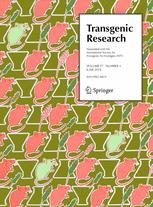Ver ítem
- xmlui.general.dspace_homeCentros Regionales y EEAsCentro Regional Entre RíosEEA ConcordiaArtículos científicosxmlui.ArtifactBrowser.ItemViewer.trail
- Inicio
- Centros Regionales y EEAs
- Centro Regional Entre Ríos
- EEA Concordia
- Artículos científicos
- Ver ítem
Citrus psorosis virus coat protein-derived hairpin construct confers stable transgenic resistance in citrus against psorosis A and B syndromes
Resumen
Citrus psorosis virus (CPsV) is the causal agent of psorosis, a serious and widespread citrus disease. Two syndromes of psorosis, PsA and PsB, have been described. PsB is the most aggressive and rampant form. Previously, we obtained Pineapple sweet orange plants transformed with a hairpin construct derived from the CPsV coat protein gene (ihpCP). Some of these plants were resistant to CPsV 90-1-1, a PsA isolate homologous to the transgene. In this study,
[ver mas...]
Citrus psorosis virus (CPsV) is the causal agent of psorosis, a serious and widespread citrus disease. Two syndromes of psorosis, PsA and PsB, have been described. PsB is the most aggressive and rampant form. Previously, we obtained Pineapple sweet orange plants transformed with a hairpin construct derived from the CPsV coat protein gene (ihpCP). Some of these plants were resistant to CPsV 90-1-1, a PsA isolate homologous to the transgene. In this study, we found that expression of the ihpCP transgene and siRNA production in lines ihpCP-10 and -15 were stable with time and propagation. In particular, line ihpCP-15 has been resistant for more than 2 years, even after re-inoculation. The ihpCP plants were also resistant against a heterologous CPsV isolate that causes severe PsB syndrome. Line ihpCP-15 manifested complete resistance while line ihpCP-10 was tolerant to the virus, although with variable behaviour, showing delay and attenuation in PsB symptoms. These lines are promising for a biotech product aimed at eradicating psorosis.
[Cerrar]

Autor
de Francesco, Agustina;
Costa, Norma Beatriz;
Garcia, Maria Laura;
Fuente
Transgenic Research 26 (2) : 225–235 (April 2017)
Fecha
2017-04
ISSN
0962-8819
1573-9368
1573-9368
Formato
pdf
Tipo de documento
artículo
Palabras Claves
Derechos de acceso
Restringido
 Excepto donde se diga explicitamente, este item se publica bajo la siguiente descripción: Creative Commons Attribution-NonCommercial-ShareAlike 2.5 Unported (CC BY-NC-SA 2.5)
Excepto donde se diga explicitamente, este item se publica bajo la siguiente descripción: Creative Commons Attribution-NonCommercial-ShareAlike 2.5 Unported (CC BY-NC-SA 2.5)

